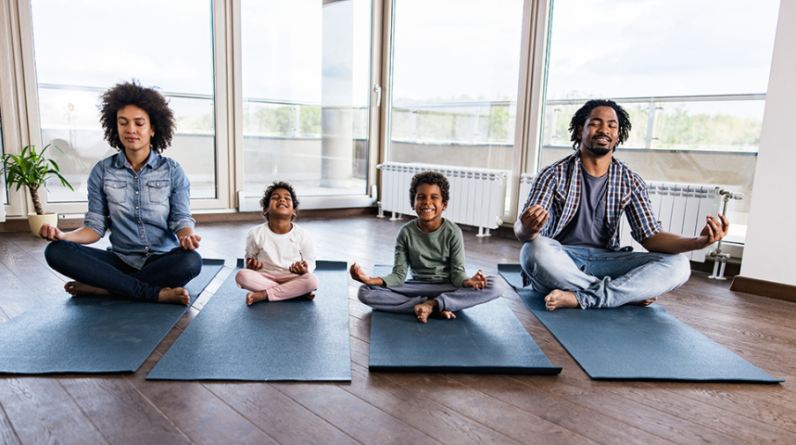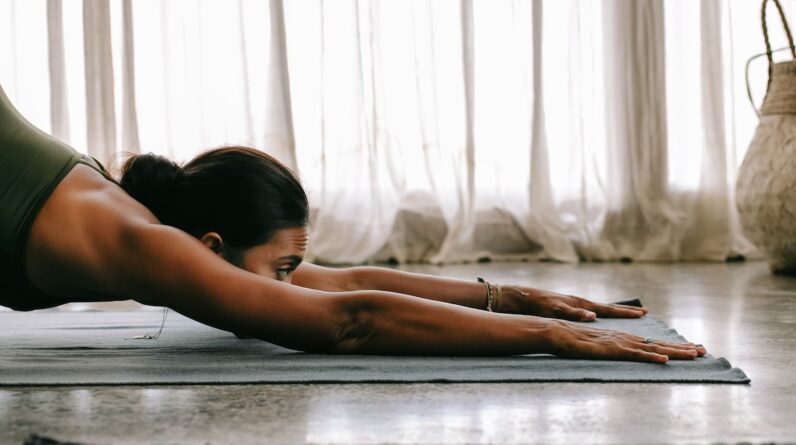
High blood pressure, also known as hypertension, is a prevalent health concern that affects millions of people worldwide. It’s often referred to as the “silent killer” because it typically doesn’t exhibit noticeable symptoms until it reaches advanced stages, increasing the risk of heart disease, stroke, and other cardiovascular complications. As the modern world grapples with stress, sedentary lifestyles, and poor dietary habits, finding effective and holistic ways to manage high blood pressure has become paramount.
In the pursuit of natural and complementary approaches to hypertension management, yoga has emerged as a compelling solution. Beyond its reputation as a physical exercise, yoga is a holistic practice that encompasses physical postures, breath control, meditation, and mindfulness. This ancient tradition has captured the attention of modern healthcare professionals and researchers for its potential to lower blood pressure, promote relaxation, and contribute to overall cardiovascular well-being.
In this article, we delve into the world of yoga and its role in managing high blood pressure. We will explore the underlying mechanisms that link yoga to blood pressure reduction, examine specific yoga poses and techniques that have shown promise, and provide practical insights on incorporating yoga into a comprehensive hypertension management plan. It’s important to note that while yoga can offer significant benefits, it should be approached as a complementary strategy alongside medical guidance and lifestyle modifications
The Role of Yoga in Hypertension Management
Hypertension management extends beyond the realm of prescription medications. While medical interventions play a crucial role in controlling high blood pressure, there’s a growing recognition of the potential of holistic practices such as yoga to complement conventional treatments. Yoga, with its emphasis on mind-body connection, breath awareness, and physical postures, offers a comprehensive approach to addressing the multifaceted factors that contribute to hypertension.
- Stress Reduction and Blood Pressure
One of the primary mechanisms through which yoga positively influences blood pressure is by reducing stress. Chronic stress can lead to elevated blood pressure levels, setting the stage for cardiovascular issues. Yoga’s incorporation of relaxation techniques, meditation, and mindfulness fosters a sense of calm and tranquillity, thereby mitigating the detrimental effects of stress on blood pressure. Scientific research has shown that regular yoga practice can activate the parasympathetic nervous system, commonly referred to as the “rest and digest” response, leading to lower heart rates and decreased blood pressure.
- Enhancing Cardiovascular Health
Yoga’s impact on blood pressure goes beyond stress reduction. The gentle stretching and controlled breathing inherent in yoga postures contribute to improved circulation and enhanced cardiovascular function. As individuals engage in poses that encourage controlled movements and deep breathing, blood vessels dilate, allowing for smoother blood flow. This improved circulation supports the heart’s efficiency and reduces the workload on the cardiovascular system, leading to a potential reduction in blood pressure.
- Mind-Body Awareness and Hypertension
Yoga’s holistic philosophy extends to fostering a heightened awareness of the mind-body connection. Practitioners are encouraged to tune into their bodies, recognising sensations, tensions, and areas of discomfort. This self-awareness can extend to recognising the early signs of rising blood pressure. Studies indicate that through regular yoga practice, individuals develop the ability to respond to their body’s signals, making it easier to implement relaxation techniques and manage stress, ultimately contributing to blood pressure control.
- Complementary Role in Lifestyle Modification
Lifestyle modifications, such as maintaining a balanced diet and engaging in regular physical activity, are cornerstones of hypertension management. Yoga seamlessly integrates with these recommendations, providing a form of exercise that enhances flexibility, muscle strength, and overall fitness. By engaging in yoga, individuals can meet their physical activity goals while simultaneously experiencing the stress-reducing benefits that contribute to blood pressure reduction.
Summary
Yoga’s influence on blood pressure encompasses stress reduction, cardiovascular health enhancement, mind-body awareness, and complementary support for lifestyle changes. By mitigating stress through relaxation, meditation, and mindfulness, yoga contributes to lower blood pressure, with research highlighting its activation of the parasympathetic nervous system. Additionally, yoga’s gentle stretches and controlled breathing improve circulation and cardiovascular function, while its holistic approach fosters self-awareness and recognition of early signs of rising blood pressure. Seamlessly integrating with dietary and exercise modifications, yoga not only enhances fitness but also offers stress reduction, collectively aiding in blood pressure management.
Yoga Poses and Techniques for Lowering Blood Pressure
Yoga’s rich repertoire of poses and techniques provides a diverse toolbox for individuals seeking to manage their blood pressure naturally. These practices emphasize relaxation, controlled breathing, and gentle movements, all of which contribute to reducing stress and promoting cardiovascular health. Let’s explore some of the key yoga poses and techniques that have shown potential for lowering blood pressure:
- Deep Breathing Exercises
Diaphragmatic Breathing (Pranayama) also known as “belly breathing,” diaphragmatic breathing involves consciously using the diaphragm to inhale deeply, expanding the abdomen rather than the chest. This technique promotes relaxation, reduces the fight-or-flight response, and helps regulate blood pressure.
- Meditation and Mindfulness
Mindfulness meditation encourages individuals to focus their attention on the present moment, cultivating awareness without judgment. Regular mindfulness practice has been linked to reduced stress and improved emotional well-being, both of which can positively impact blood pressure levels.
Here’s how to practice mindful meditation:
- Find a Quiet Space: Sit in a comfortable position with your back straight. Close your eyes and take a few deep breaths to centre yourself.
- Focus on Your Breath: Pay attention to the sensation of your breath as you inhale and exhale. Feel the rise and fall of your chest or the movement of your abdomen.
- Observe Your Thoughts: As thoughts arise, acknowledge them without judgment and gently bring your focus back to your breath. Avoid getting caught up in the content of your thoughts.
- Expand Your Awareness: Gradually expand your awareness to include the sensations in your body, sounds in your environment, and any feelings or emotions you’re experiencing.
- Stay Present: Continuously bring your attention back to the present moment whenever your mind wanders. Be patient with yourself; it’s normal for thoughts to come and go.
- Practice Duration: Start with 5-10 minutes of mindful meditation and gradually increase the duration as you become more accustomed to the practice.
- Yoga Poses for Hypertension
I. Child’s Pose (Balasana)
This gentle resting pose involves kneeling with the forehead on the mat and arms extended in front. Child’s Pose promotes relaxation and can help reduce stress, contributing to blood pressure management.
How to Perform
- Start on Your Hands and Knees: Begin in a tabletop position with your hands and knees on the mat.
- Lower Your Hips: Sit back on your heels and extend your arms forward, lowering your chest toward the mat.
- Relax and Breathe: Rest your forehead on the mat and let your body relax. Breathe deeply and evenly as you hold the pose.
- Hold and Release: Hold the Child’s Pose for 1-3 minutes or as long as is comfortable. To release, gently rise up on an inhale.
II. Corpse Pose (Savasana)
Savasana is a relaxation pose where individuals lie flat on their backs with arms and legs spread comfortably. It allows for deep rest and relaxation, aiding in stress reduction and promoting overall calmness.
How To Perform
- Lie Down: Lie flat on your back on a comfortable surface, such as a yoga mat or carpet.
- Relax Your Body: Let your arms rest by your sides, palms facing up, and allow your legs to relax with your feet falling outward.
- Close Your Eyes: Close your eyes and take slow, deep breaths. Focus on releasing tension from each part of your body.
- Stay Present: As you lie in Savasana, stay present in the moment, letting go of any thoughts or distractions.
- Practice Duration: Savasana can be practiced for 5-15 minutes, or even longer if you wish.
III. Legs-Up-the-Wall Pose (Viparita Karani)
In this pose, practitioners lie on their backs with their legs extended vertically against a wall. This gentle inversion encourages circulation and relaxation, potentially aiding blood pressure regulation.
How To Perform
- Sit Sideways to the Wall: Sit with your side against a wall, legs extended along the floor.
- Swing Your Legs Up: Gently swing your legs up the wall as you lie down on your back. Your hips should be close to the wall, and your legs should rest against it.
- Relax and Breathe: Allow your arms to rest by your sides, palms facing up. Relax your entire body and breathe deeply.
- Hold and Release: Stay in this pose for 5-15 minutes, focusing on your breath and the sensation of relaxation. To release, bend your knees and roll to the side.
- Pranayama Techniques:
I. Anulom Vilom (Alternate Nostril Breathing)
This pranayama technique involves alternating the breath between the left and right nostrils. Anulom Vilom is believed to balance energy, promote relaxation, and support cardiovascular health.
II. Ujjayi Breathing
Ujjayi breath involves slightly constricting the back of the throat while breathing deeply through the nose. This audible breath calms the mind and may have a positive impact on blood pressure and stress.
Creating a Yoga Routine for Hypertension
Designing a personalised yoga routine tailored to your needs and goals can be an empowering way to manage hypertension and enhance overall well-being. A well-rounded routine incorporates various yoga practices to promote relaxation, reduce stress, and support cardiovascular health. Here’s a step-by-step guide to creating your own yoga routine:
- Assess Your Current State
Before creating your routine, assess your current fitness level, any existing health conditions, and your familiarity with yoga. Be honest with yourself about your strengths, limitations, and any precautions you should take.
- Set Clear Goals
Identify your goals for practising yoga. Do you want to reduce stress, lower blood pressure, increase flexibility, or improve overall fitness? Setting clear goals will help you choose appropriate practices and track your progress.
- Create a Balanced Sequence
Arrange your chosen practices in a sequence that flows smoothly from one to the next. Begin with breathing exercises to centre yourself, followed by meditation to set a calm tone. Then transition into gentle yoga poses, gradually progressing to more active poses if appropriate. End with relaxation in Corpse Pose or Savasana.
- Determine Frequency:
Decide how often you’ll practice your yoga routine. Aim for consistency rather than intensity. Starting with 2-3 sessions per week is a reasonable goal. As you become more comfortable, you can gradually increase the frequency.
- Be Mindful of Safety
Listen to your body and practice within your limits. If you have any health concerns or physical limitations, modify poses or seek guidance from a yoga instructor. Avoid pushing yourself too hard, as yoga should feel nurturing and not strain your body. Your body’s response is your best guide. If a practice causes discomfort or pain, modify or skip it. Yoga should leave you feeling refreshed and energized, not fatigued or strained.
Precautions and Considerations
While yoga offers numerous benefits for managing hypertension, it’s essential to approach your practice with mindfulness and consideration of your individual health status. As you embark on your yoga journey, keep these precautions and considerations in mind to ensure a safe and effective experience:
- Consult Your Healthcare Provider:
Before starting a new exercise regimen, especially if you have hypertension or other health conditions, consult your healthcare provider. They can provide insights into any specific precautions you should take and offer guidance on integrating yoga into your overall wellness plan.
- Practice Moderation
While yoga can provide immense benefits, avoid overexertion. Listen to your body and avoid pushing yourself to the point of strain. Overexertion can lead to elevated blood pressure and other complications.
- Modify Poses as Needed
If you have any health concerns, injuries, or physical limitations, don’t hesitate to modify poses. Use props or variations to make poses more accessible and comfortable. Your safety should always come first.
- Avoid Inversions and High-Intensity Poses
Inversions (poses where your head is below your heart) and high-intensity poses can cause a sudden spike in blood pressure. If you have hypertension, it’s advisable to avoid or approach these poses with caution and under the guidance of a qualified instructor.
- Stay Hydrated
Proper hydration is crucial during any physical activity, including yoga. Dehydration can affect blood pressure levels, so make sure to drink water before, during, and after your practice.
- Monitor Your Body’s Response
Pay attention to how your body responds during and after your yoga practice. If you experience dizziness, shortness of breath, chest pain, or any other unusual symptoms, stop the practice and seek medical attention if necessary.
- Be Patient
Yoga is a journey, and results may not be immediate. Be patient with yourself and embrace the process. Over time, with consistent practice, you’re likely to experience the positive effects of yoga on your blood pressure and overall well-being.
- Respect Your Limits
Remember that your body is unique, and your experience with yoga may differ from others. Avoid comparing yourself to others and focus on what feels right for you.
how2fit Suggestion
Yoga helps reduce stress, improve flexibility, and increase relaxation, all of which can contribute to lower blood pressure. However, it’s important to remember that yoga alone may not be a substitute for medical treatment if you have high blood pressure.
Along with yoga, it is important that you take care of your diet to reduce blood pressure. Keep sodium low in your diet and have a lot of vegetables and fruits. Cumulatively diet, and yoga can help.
Conclusion
In essence, the practice of yoga becomes a conduit through which individuals can find tranquillity, strength, and resilience, ultimately leading to better cardiovascular health and holistic wellness. By embracing yoga’s wisdom and integrating it into daily life, one can embark on a transformative journey toward improved blood pressure, realizing the harmony between the body, mind, and spirit.
Disclaimer: The purpose of this article is just to disperse knowledge and raise awareness. It does not intend to replace medical advice from professionals. For further information please contact our certified nutritionists Here
Frequently Asked Questions (FAQs)
Can yoga help lower high blood pressure?
Yes, yoga has the potential to help lower high blood pressure through relaxation, stress reduction, and improved overall well-being.
What are the potential benefits of practising yoga for hypertension?
Practising yoga can lead to stress reduction, improved circulation, enhanced cardiovascular health, and heightened mind-body awareness, all of which contribute to managing hypertension.
Is yoga safe for individuals with high blood pressure?
In most cases, yes. However, consulting a healthcare provider before starting a new exercise regimen, including yoga, is advisable, especially for those with preexisting medical conditions.
Are there specific yoga poses or asanas recommended for managing hypertension?
Gentle poses like Child’s Pose, Corpse Pose, and Legs-Up-the-Wall Pose are often recommended for hypertension management.
How does yoga impact stress and its relation to high blood pressure?
Yoga promotes relaxation, reduces stress, and activates the parasympathetic nervous system, which can lead to lower blood pressure levels.
Can yoga be used as a complementary therapy alongside medication for hypertension?
Yes, yoga can complement medical treatment for hypertension by addressing stress and promoting overall cardiovascular health.
Is it necessary to have prior yoga experience to start practising for high blood pressure?
No, prior experience is not necessary. Beginners can start with simple poses and gradually build their practice.
Can yoga and meditation help with relaxation and stress reduction, thereby aiding blood pressure management?
Absolutely, yoga and meditation techniques are effective tools for relaxation and stress reduction, which can positively impact blood pressure.
Reference Links
- Effect of long-term yoga training on autonomic function among healthy adults: https://www.ncbi.nlm.nih.gov/pmc/articles/PMC3679769/
- Effectiveness of Yoga for Hypertension: Systematic Review and Meta-Analysis: https://www.ncbi.nlm.nih.gov/pmc/articles/PMC3679769/







